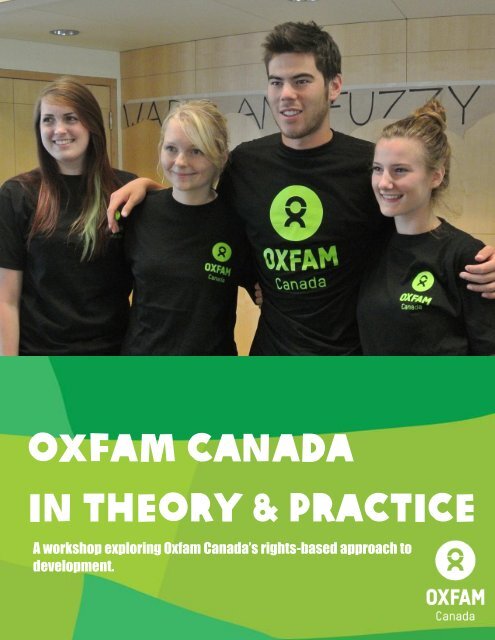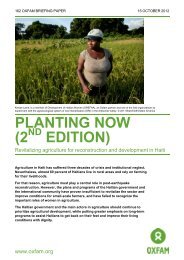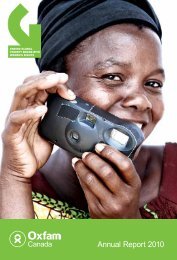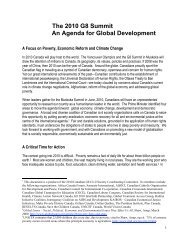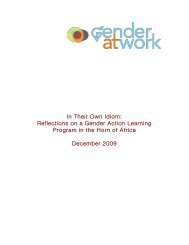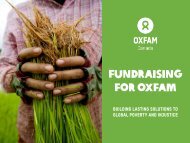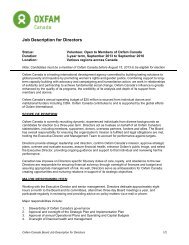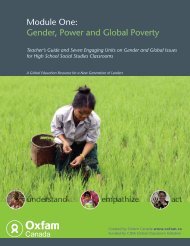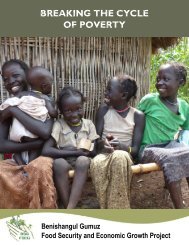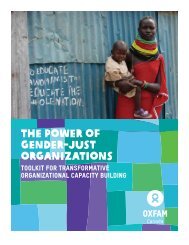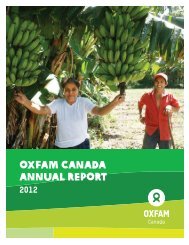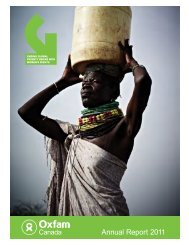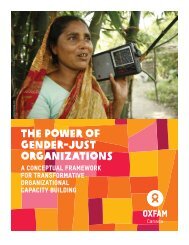in theory and practice - Oxfam Canada
in theory and practice - Oxfam Canada
in theory and practice - Oxfam Canada
Create successful ePaper yourself
Turn your PDF publications into a flip-book with our unique Google optimized e-Paper software.
<strong>Oxfam</strong> <strong>Canada</strong><br />
In Theory & Practice<br />
A workshop explor<strong>in</strong>g <strong>Oxfam</strong> <strong>Canada</strong>’s rights-based approach to<br />
development.<br />
17
Session Outl<strong>in</strong>e<br />
This session builds knowledge <strong>and</strong> attitudes through how <strong>Oxfam</strong> <strong>Canada</strong><br />
views development, <strong>and</strong> how <strong>Oxfam</strong> <strong>Canada</strong> operationalizes its vision of<br />
development. Through group discussion on different development<br />
perspectives, participants will be able to underst<strong>and</strong> why <strong>Oxfam</strong> <strong>Canada</strong><br />
takes a rights-based approach. Participants will then explore an <strong>in</strong>-depth<br />
case study of a particular <strong>Oxfam</strong> partner – ANAP.<br />
Length of Session<br />
1 Hour<br />
Materials<br />
Chart paper<br />
Markers<br />
Intended Group Size<br />
40 People<br />
Pr<strong>in</strong>ted h<strong>and</strong> outs<br />
Introduction (10 m<strong>in</strong>utes)<br />
Expla<strong>in</strong> the activity <strong>and</strong> briefly guide participants through the goals of the<br />
session, noted above, the structure of the session, <strong>and</strong> the background<br />
<strong>in</strong>formation for the discussion activity.<br />
Split the group <strong>in</strong>to smaller groups of six to eight. The groups will be selfmoderated<br />
with the facilitators walk<strong>in</strong>g around to help keep conversation<br />
flow<strong>in</strong>g.<br />
Discussion (20 m<strong>in</strong>utes)<br />
The h<strong>and</strong>-out outl<strong>in</strong>es three approaches to development (1) a rightsbased<br />
approach (2) a needs-based approach, <strong>and</strong> (3) a market-based<br />
approach. The h<strong>and</strong> out provides the follow<strong>in</strong>g <strong>in</strong>formation on each<br />
approach:<br />
What is the approach?<br />
How should we deal with this approach?<br />
What actions can we take?<br />
What are reasons to support this approach?<br />
What are the reasons to oppose this approach?<br />
Download the h<strong>and</strong>out used <strong>in</strong> the activity.<br />
https://docs.google.com/document/d/1pcJt9IEDs7i582y2Cex7rgyJ0aCGq<br />
YsS2QqtJIq7kig/edit<br />
Facilitators will ask groups to consider the follow<strong>in</strong>g three questions over<br />
the course of 20 m<strong>in</strong>utes. Groups will self-moderate their discussion, with<br />
the facilitators circulat<strong>in</strong>g to ensure questions are answered or to <strong>in</strong>ject<br />
th<strong>in</strong>k<strong>in</strong>g <strong>in</strong>to the conversation.<br />
18<br />
Is one approach more effective than another at eradicat<strong>in</strong>g poverty?<br />
Is one approach more effective than another at ensur<strong>in</strong>g food<br />
security?<br />
Is one approach more effective than another at creat<strong>in</strong>g gender<br />
equity?
If groups are be<strong>in</strong>g hav<strong>in</strong>g a difficult time answer<strong>in</strong>g the questions above,<br />
alternative questions can be used, <strong>in</strong>clud<strong>in</strong>g the follow<strong>in</strong>g:<br />
What do you like about this approach <strong>and</strong>/or what do you th<strong>in</strong>k are<br />
the advantages of this approach?<br />
What don’t you like about this approach <strong>and</strong>/or what do you th<strong>in</strong>k are<br />
the challenges of this approach?<br />
Does anyth<strong>in</strong>g surprise you?<br />
Com<strong>in</strong>g back together (10 m<strong>in</strong>utes)<br />
The facilitator will ask that one person from each group to briefly<br />
summarize someth<strong>in</strong>g that surprised them or someth<strong>in</strong>g that caused<br />
vary<strong>in</strong>g op<strong>in</strong>ions with<strong>in</strong> their group.<br />
Consider the follow<strong>in</strong>g questions as a group:<br />
How do you th<strong>in</strong>k different models of development were created?<br />
Do you th<strong>in</strong>k one approach is more relevant today than others?<br />
<strong>Oxfam</strong> <strong>Canada</strong> project (20 m<strong>in</strong>utes)<br />
The facilitator will briefly present a rights-based approach project or<br />
program with a visual aid. This can be done by another facilitator, who<br />
will draw correspond<strong>in</strong>g draw<strong>in</strong>gs so that the audience can keep track of<br />
the story. Instead of be<strong>in</strong>g a lecture style presentation, this will be a<br />
story-style presentation of a project.<br />
Then, ask if the students have any further questions.<br />
This session was piloted with a summarized story of <strong>Oxfam</strong> <strong>Canada</strong>’s<br />
Engender<strong>in</strong>g Change Program with Cuban partners ANAP.<br />
Download the story summery to create your own draw<strong>in</strong>g here.<br />
https://docs.google.com/document/d/1JeqHjtXY7AkTaau2UpbT6vSIWF2<br />
xhB<strong>in</strong>MY567N0AiOE/edit?pli=1#head<strong>in</strong>g=h.fmjqvnc620f1<br />
19<br />
If there are additional questions, contact the <strong>Oxfam</strong> <strong>Canada</strong> national<br />
office at 613-237-5236
Participant Experience<br />
What are different approaches to <strong>in</strong>ternational development?<br />
Rights-based approach: The rights holders do not have the ability (be that<br />
knowledge, capacity, or resources) to fulfill their rights. It is most often women who<br />
cannot fulfill their rights.<br />
Needs-based approach: People liv<strong>in</strong>g <strong>in</strong> poverty deserve help <strong>and</strong> support, no<br />
matter who provides it <strong>and</strong> how long they can provide it for. Services should be<br />
designed to target <strong>and</strong> meet the needs of the most vulnerable - ma<strong>in</strong>ly women <strong>and</strong><br />
marg<strong>in</strong>alized groups.<br />
Market-based approach: An economy with a fully able work<strong>in</strong>g population <strong>and</strong> an<br />
enabl<strong>in</strong>g environment will experience susta<strong>in</strong>able, <strong>in</strong>clusive, <strong>and</strong> equitable<br />
economic growth. It focuses on identify<strong>in</strong>g economic opportunities for those <strong>in</strong><br />
poverty - specifically focus<strong>in</strong>g on the role of women as economic <strong>and</strong><br />
entrepreneurial agents.<br />
How does each approach best ensure food security?<br />
Rights-based approach: Women produce upwards of 60% of food <strong>in</strong> most<br />
develop<strong>in</strong>g countries – given their crucial role <strong>in</strong> food production <strong>and</strong> provision,<br />
susta<strong>in</strong>able food security strategies must <strong>in</strong>clude ensur<strong>in</strong>g access to l<strong>and</strong>, credit<br />
<strong>and</strong> other productivity enhanc<strong>in</strong>g <strong>in</strong>puts <strong>and</strong> services for women.<br />
Needs-based approach: This perspective focuses on the basic human requires of<br />
food, water, shelter <strong>and</strong> security – those <strong>in</strong> fam<strong>in</strong>e <strong>and</strong> drought stricken areas will<br />
receive food aid or cash transfers.<br />
Market-based approach: This approach looks to <strong>in</strong>crease agricultural productivity<br />
among all farmers (i.e. <strong>in</strong>puts such as l<strong>and</strong>, credit, seeds, etc.) <strong>and</strong> connect<br />
farmers <strong>and</strong> consumers to local markets to <strong>in</strong>crease their market participation.<br />
How does each approach best ensure food security?<br />
Rights-based approach: Women produce upwards of 60% of food <strong>in</strong> most<br />
develop<strong>in</strong>g countries – given their crucial role <strong>in</strong> food production <strong>and</strong> provision,<br />
susta<strong>in</strong>able food security strategies must <strong>in</strong>clude ensur<strong>in</strong>g access to l<strong>and</strong>, credit<br />
<strong>and</strong> other productivity enhanc<strong>in</strong>g <strong>in</strong>puts <strong>and</strong> services for women.<br />
Needs-based approach: This perspective focuses on the basic human requires of<br />
food, water, shelter <strong>and</strong> security – those <strong>in</strong> fam<strong>in</strong>e <strong>and</strong> drought stricken areas will<br />
receive food aid or cash transfers.<br />
Market-based approach: This approach looks to <strong>in</strong>crease agricultural productivity<br />
among all farmers (i.e. <strong>in</strong>puts such as l<strong>and</strong>, credit, seeds, etc.) <strong>and</strong> connect<br />
farmers <strong>and</strong> consumers to local markets to <strong>in</strong>crease their market participation.<br />
20
How do these theories work together to help poverty reduction?<br />
The rights-based approach <strong>and</strong> market-based approach can work together to<br />
address systemic issues <strong>in</strong> poverty <strong>and</strong> gender equality. First, by women lead<strong>in</strong>g<br />
<strong>and</strong> realiz<strong>in</strong>g their own rights, second, by empower<strong>in</strong>g women to become<br />
economically active <strong>and</strong> productive, lead<strong>in</strong>g to prosperity <strong>and</strong> poverty reduction.<br />
The needs-based approach is most effective <strong>in</strong> emergency situations, such as<br />
drought or floods.<br />
How do we see <strong>Oxfam</strong>’s approach <strong>in</strong> real life?<br />
The rights-based approach can be conceptualized <strong>in</strong> many different ways, but the<br />
example that was exam<strong>in</strong>ed was the case of a farmer’s association <strong>in</strong> Cuba called<br />
ANAP which represented thous<strong>and</strong>s of farmers.<br />
<strong>Oxfam</strong> <strong>Canada</strong> worked with ANAP to develop a gender strategy, <strong>and</strong> then helped<br />
its implementation. Activities <strong>in</strong>cluded spread<strong>in</strong>g the gender strategy through<br />
magaz<strong>in</strong>es <strong>and</strong> radio, conduct<strong>in</strong>g gender workshops, <strong>and</strong> the provision of a fund<br />
that communities could use to further gender equality <strong>in</strong> their communities<br />
(through sensitization activities).<br />
What are next steps, goals, discussions, etc?<br />
Discussion should cont<strong>in</strong>ue on what exactly are the best approaches for food<br />
security, women’s rights <strong>and</strong> poverty reduction<br />
To help with tabl<strong>in</strong>g <strong>and</strong> communicat<strong>in</strong>g <strong>Oxfam</strong> <strong>Canada</strong> to others, ensure that your<br />
group underst<strong>and</strong>s the differences of the three approaches <strong>and</strong> why <strong>Oxfam</strong><br />
<strong>Canada</strong> utilizes a rights-based approach<br />
21
Resources<br />
Batliwala, S. (n.d.). When rights go wrong – distort<strong>in</strong>g the rightsbased<br />
approach to development. Boston: Hauser Center for Nonprofit<br />
Organizations. Retrieved from:<br />
www.justassociates.org/WhenRightsGoWrong.pdf<br />
Flynn, D. (2005). What’s wrong with rights? Reth<strong>in</strong>k<strong>in</strong>g human<br />
rights <strong>and</strong> responsibilities. Australian Social Work 58(3), 244-256.<br />
McCla<strong>in</strong>-Nhlapo, C. (2004). Implement<strong>in</strong>g a human rights approach to<br />
food security. Retrieved from:<br />
http://www.ifpri.org/sites/default/files/pubs/pubs/ib/ib29.pdf<br />
Mutua, M. (2008). Human rights: a political <strong>and</strong> cultural critique.<br />
Philadelphia: University of Pennsylvania Press.<br />
Offenheiser, R.C.m <strong>and</strong> Holcombe, S.H. (2003). Challenges <strong>and</strong><br />
opportunities <strong>in</strong> implement<strong>in</strong>g a rights-based approach to<br />
development: an <strong>Oxfam</strong> America perspective. Nonprofit <strong>and</strong> Voluntary<br />
Sector Quarterly 32, 268-301.<br />
Poulton, C. And Dorward, A. (2003). The role of market based<br />
economic development <strong>in</strong> strengthen<strong>in</strong>g food security. Retrieved<br />
from: http://www.odi.org.uk/work/projects/03-food-securityforum/docs/markets_theme2.pdf<br />
The World Bank (2012). World development report: gender equality<br />
<strong>and</strong> development. Retrieved from:<br />
http://siteresources.worldbank.org/INTWDR2012/Resources/7778105-<br />
1299699968583/7786210-1315936222006/Complete-Report.pdf<br />
United Nations Population Fund. (n.d.). Women’s economic<br />
empowerment: meet<strong>in</strong>g the needs of impoverished women.<br />
Retrieved from:<br />
http://www.unfpa.org/webdav/site/global/shared/documents/publications/<br />
2007/women_economic.pdf<br />
22


